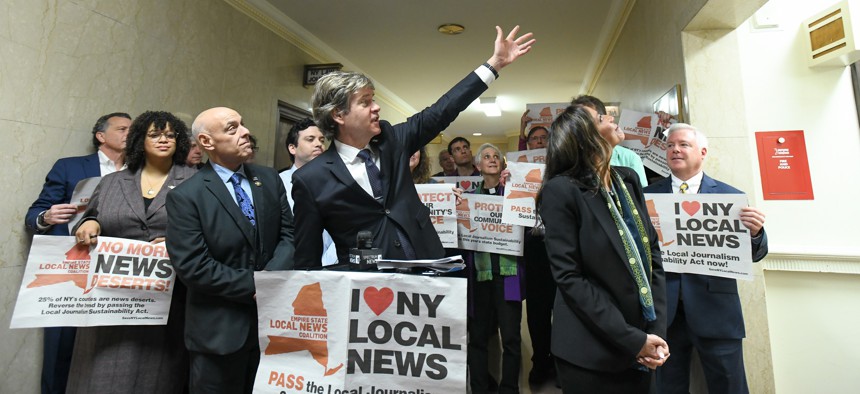This year’s state budget includes a welcome boost for local news outlets: $90 million over three years in payroll tax credits for locally owned media companies. Adapted from the Local Journalism Sustainability Act, a bill originally introduced in 2021 by state Sen. Brad Hoylman-Sigal and Assembly Member Carrie Woerner, the tax credit allows each locally owned newsroom to receive tax credits equal to 50% of its reporters’ full-time salaries (up to a maximum of $50,000 per reporter and $300,000 in total), plus another $5,000 in tax credits for each net new job created (up to $20,000). The tax credit was championed by the Empire State Local News Coalition, which included more than 200 print and digital newspapers from across the state, as well as the New York News Publishers Association, the NewsGuild-CWA union and the state AFL-CIO.
City & State caught up with Hoylman-Sigal the day after the budget was finally passed to discuss the new tax credit and the importance of funding local news. This interview has been edited for length and clarity.
Tell us a bit about this new tax credit for local news outlets.
It’s the first in the nation. So there weren’t a lot of examples, except there’s a bill at the federal level that has not been successful. What we heard from our colleagues is that in their neighborhoods and communities and towns and villages across New York state, newspapers have had to close by the dozens in recent years. For an elected official, that’s problematic because we need our voters to be informed. When there is significant media consolidation, as we’ve seen, where newspaper chains and newspapers go out of business, the sources of news are extremely limited. It’s becoming increasingly difficult to get that hyperlocal news coverage, which is essential, I would say, to a deliberative democracy where people need to be educated to vote wisely.
There are efforts like this across the country. Different states are looking at this type of model. I’m really proud that New York is the first and hopefully we can serve as an example for other states and even the federal government to follow suit. Because this is not a problem just in New York. But it is particularly important in New York, since we think of ourselves as the media capital of the world. Now we’re putting our money where our mouth is for that slogan by creating this $90 million tax credit.
There are so many different types of media outlets – from local news sites to newspaper chains owned by private equity companies. How did you determine which ones should be eligible for the tax credit?
I would say a journalist’s job is an important job, no matter who they work for. So I don’t necessarily personally differentiate, but I do understand and appreciate that we want locally owned sources and those tend to be more sensitive and responsive to realities on the ground in some of our communities.
Is it true that large out-of-state newspaper chains opposed the inclusion of the tax credit in the budget?
I think in the end, we addressed concerns from different industry perspectives. I don’t think that was an issue, to be honest. At the end of the day, we got it across the finish line. I think the main opponent that we had to this tax credit was time because the interest in putting it in the budget came late in our efforts, and we needed to have the language ready for, obviously, the last budget bill. That was our main challenge in getting across the finish line, making sure that it applied to different sources of news but also having enough time to write the bill and have it reviewed and have it be included in the budget.
Is there any interest in potentially expanding the tax credit in the future to cover newsrooms that are not locally owned?
I so strongly believe in this profession and New York’s role as the media capital of the world that I would be open to further expansion. But like a lot of tax credits, I think any expansion would have to first be proven by the tax credits, and we’ll see how it goes once the regulations are written and the tax credit is up and running. Frankly, I think this is going to be a model for other states and even the federal government. But we have to show that it works.
I really applaud the governor and my colleagues for supporting it. I’ll note that (state Senate Majority Leader) Andrea Stewart-Cousins is a former local journalist. So I know that had something to do with the fact that we were able to include this in the one-house budget. She understands intimately how local news is connected to our democracy, having worked as a reporter herself earlier in her career.
Were there any differences between the version of the tax credit included in the Senate one-house and the version in the final budget?
Frankly, this credit is bigger than the one that we had proposed, which is really gratifying that the governor wanted to go even bigger. I think that had something to do with the unions CWA and AFL-CIO supporting it. Look, last year, we did a video gaming tax credit. I would proffer that these jobs are as important if not more important than jobs in the digital gaming sphere. So I’m glad that that was recognized. The impact on not just community media but ethnic media was also an important consideration. For example, the Amsterdam News, (one of the) oldest Black-owned newspapers in the country, is struggling as are many papers. I’m hopeful that this gives them a lifeline.
NEXT STORY: This week’s biggest Winners & Losers


